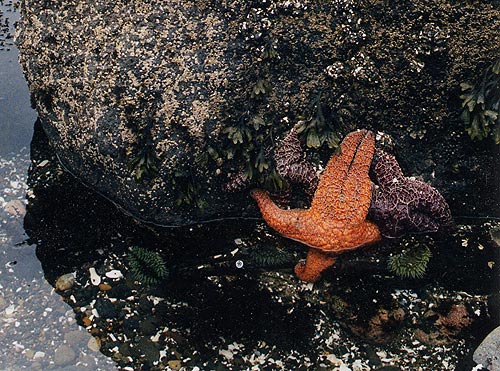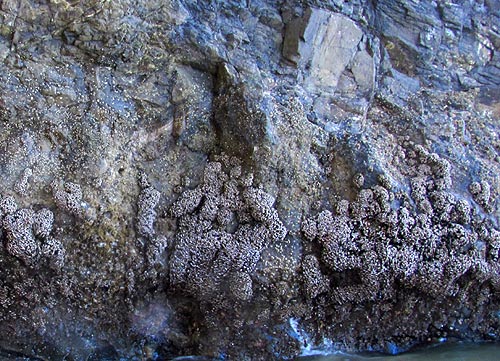Oregon Coast Scientists' Remarkable Discoveries on Sea Stars, Underwater Vents
Published 06/12/2016 at 8:51 PM PDT
By Oregon Coast Beach Connection staff

(Oregon Coast) – A stunning set of finds from scientists lately regarding undersea hydrothermal vents and sea stars have the marine world abuzz. Researchers from the Oregon coast and its Hatfield Marine Science Center are largely responsible, along with their inland counterparts at Corvallis' Oregon State University.
It seems the wowing array of underwater hot gas vents and the methane that regularly seeps up from the ocean floor are connected to the greater climate of the entire planet, according to some new findings.
Researchers from Oregon – including OSU and Newport's Hatfield Marine Science Center – first discovered these underwater oddities some 40 years ago. It was a big surprise to the scientific world, filled with hot oozing gases, sulfide chimneys, bizarre tube worms and giant crabs and mussels – life forms that were later found to eat methane and toxic sulfide.
Recent research has revealed that these spots are not really anomalies, however. They are prevent throughout the world's oceans, and they provide about 13 percent of the energy coming into the sea, making all kinds of marine life possible.

Photo above courtesy Hatfield Marine Science Center: tube worms that live off of thermal vents.
Now, scientists like Andrew Thurber, an assistant professor in the OSU College of Earth, Ocean and Atmospheric Sciences, headed up a recent report that shows the hydrothermal vents create an integral habitat for forms of phytoplankton who are in turn integral to Earth's climate. They live on the gases and minerals that come out of the vents, and then these life forms in turn consume some 90 percent of the methane released by the ocean floor. This keeps it from entering the atmosphere, where as a greenhouse gas it is 25 times more potent than carbon dioxide.
These vent areas also create a rich habit of extensive mussel and clam beds, and mounds of shrimp and crab. They create some prime fishing habitat and literally fertilize the ocean as zooplankton biomass and abundance increases.
These particular kinds of habitats can exist for tens of thousands of years, according to Thurber and his team.
A large group of Oregon State University and Hatfiled scientists also released some promising finds on the recovery of sea stars (often known as starfish), after the population here was severely impacted by a form of wasting disease.

Photo above courtesy Hatfield Marine Science Center: sea star wasting disease this past year.
An unprecedented number of baby sea stars have been observed all around the Oregon coast in recent months, signaling a possible recovery. But it's not guaranteed, and scientists such as Bruce Menge, from the Wayne and Gladys Valley Professor of Marine Biology at Oregon State University, say it does not mean the disease is over.
Menge said 2014 survey of the sea star population showed a definite drop in juveniles. That changed not long after, however.
“But a few months later, the number of juveniles was off the charts,” Menge said. “Higher than we’d ever seen – as much as 300 times normal.”
Menge cautions on what this means, however. He said it's not that there were more sea stars being born, but simply that more – many, many more – made it from the larval stage into the juvenile stage. If these are able to later become adults is another question.
The reason for so many new young ones is surprising as well: it's all about the sudden abundance of food. The young sea stars feed on larval and juvenile mussels and barnacles, competing with adult sea stars for the same food source. The scarcity of adults provided a temporary smorgasbord for the juveniles.
Because of the disease, some parts of the Oregon coast saw their sea star populations drop by 63 percent of its normal numbers all the way down to 84 percent.
Scientists from Cornell University believed the epidemic was due to a sea star-associated Densovirus, and researchers from Washington chimed in saying that warmer water in the region may have triggered that. Menge's group had different findings, noting the epidemic hit its peak when waters of the Oregon coast had gotten colder. Ocean acidification is one culprit Menge's group is looking at, but they believe it will come down to several factors. Oregon Coast Lodgings for this - Where to eat - Maps - Virtual Tours


More About Oregon Coast hotels, lodging.....
More About Oregon Coast Restaurants, Dining.....
Cannon Beach Lodging
Nehalem Bay Lodgings
Manzanita Hotels, Lodging
Three Capes Lodging
Pacific City Hotels, Lodging
Lincoln City Lodging
Depoe Bay Lodging
Newport Lodging
Waldport Lodging
Yachats Lodging
Oregon Coast Vacation Rentals
Oregon Coast Lodging Specials
LATEST Related Oregon Coast Articles
Likely just before dawn best hour but peak happens during daylight. Weather
Dark Sky Week is Prime Along Oregon Coast: Where and Where Not to Go
General guide to dark sky viewing from south to north coast. Astronomy
Sizable Price Drop, Deals in Lincoln City During Quiet of April on Central Or...
20 perc off at A1 Vacation Rentals across its roster, including Gleneden Beach. Lincoln City specials
Upcoming S. Oregon Coast Events Include Gem Show, History: Coos Bay, Bandon
May 6 talk at Coos History Museum, Mayfly Fest May 17, Bandon Rock / Gem Show June 7,8
Washington Coast Cleanup on April 19 - Coinciding with Oregon Coast's SOLVE E...
From the Puget Sound to Long Beach, alongside Oregon's cleanup. Washington coast events, Seaside events
Astoria's Riverwalk Gets New Lighting, More N. Oregon Coast Roadwork
Delays coming this summer, but the riverwalk has a new look. Seaside, Cannn Beach
April Gets Even Cheaper Midweek at Depoe Bay, Lincoln City: Oregon Coast Deals
Off-season rates plus more at Keystone Vacation Rentals. Depoe Bay lodging specials, Lincoln City hotel reviews, Newport hotel reviews
Washington Coast Begins Week of Clam Digs, April 12 Through 18
Long Beach, Twin Harbors, Mocrocks and Copalis at different times. Washington coast events
Back to Oregon Coast
Contact Advertise on BeachConnection.net
All Content, unless otherwise attributed, copyright BeachConnection.net Unauthorized use or publication is not permitted














































